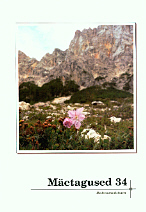Laste hooldamise ja lastehaiguste ravimise traditsioonilised viisid bessermanidel
Traditional Childcare and Treatment of Children's Diseases among the Besermian
Author(s): Elena PopovaSubject(s): Customs / Folklore
Published by: Eesti Kirjandusmuuseum
Keywords: labour; folk medicine; children's diseases; mythological diseases; midwife; healer; Besermian
Summary/Abstract: The article is based on fieldwork conducted during 1986-2000 among the Besermian (a small ethnic group in North-East Udmurtia, the districts of Iukamen, Iar, Balezino and Glazov, and the Cheptsa watershed). The article overviews the beliefs, customs and healing practices related to labour, care of the mother and the newborn. A child is not completely physically formed by the time it is born, and its arrival in this world does not mean that labour is over. Owing to this reason, the child had to be "completed". In the first weeks and months, attempts to achieve the child's correct physical shape were made. This applied particularly to premature babies. A prematurely born baby was wrapped in sheepskin, held in a fur coat's sleeve, or warmed on the oven until it turned nine months old, so that the child could "become ripe". In the first few months after it was born, the newborn lied in the cradle. Women usually continued with their household duties already in the first few days following childbirth, and partook in field chores far away from home, in the field or woods. To be able to take care of and nurse the child, women took it along. Children were carried in various specially designed rucksacks. A separate group of taboos and beliefs is associated with children's clothes, especially to designing, wearing, keeping and washing the clothes. In everyday life, the rules that were concerned with possible harm to the child's personality, behaviour and fate were strictly observed. For example, it was forbidden to put kitchen utensils, especially sieves, on one's head during play, as it was believed that a child would remain short. An infant was not shown a mirror, otherwise it might sleep restlessly. The basic food of infants was breast milk, and since feeding was irregular, the child was fed when it was hungry or cried. Breast milk remained a child's basic food until it turned two or three years old, or until the next child was born. Also, Besermian midwives and verbal healers and their practices are reviewed. The Besermian retained traditional medicine longer than the neighbouring groups, especially as regards the methods for treating children. Diseases and healing practices of complex mythological background are gradually forgotten, knowledge and practices passed on within a family have survived better. Children's diseases and prophylactics are treated similarly to these of adults. Receiving health from an adult and the ritual of "new" birth played an important role.
Journal: Mäetagused. Hüperajakiri
- Issue Year: 2006
- Issue No: 34
- Page Range: 31-56
- Page Count: 26
- Language: Estonian

